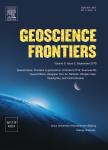The first pterosaur 3-D egg:Implications for Pterodaustro guinazui nesting strategies,an Albian filter feeder pterosaur from central Argentina
The first pterosaur 3-D egg:Implications for Pterodaustro guinazui nesting strategies,an Albian filter feeder pterosaur from central Argentina作者机构:Centro Regional de Investigaciones Científicas y Transferencia Tecnológica de La Rioja (CRILAR-CONICET)Entre Ríos y Mendoza s/nAnillaco5301 La RiojaArgentina Orcas Island Historical MuseumsUSA School of Biological Sciences (A08)University of SydneyNSW 2006Australia CONICETArgentina Centro de Investigaciones Paleobiológicas (CIPAL)Universidad Nacional de CórdobaAv.Vélez Sarsfield 2995000 CórdobaArgentina Departamento de GeologíaUniversidad Nacional de San LuisSan LuisArgentina
出 版 物:《Geoscience Frontiers》 (地学前缘(英文版))
年 卷 期:2014年第5卷第6期
页 面:759-765页
核心收录:
学科分类:070903[理学-古生物学与地层学(含:古人类学)] 0709[理学-地质学] 07[理学] 0708[理学-地球物理学] 0704[理学-天文学]
主 题:Pterosaur fossil eggsPterosaur eggshellPterodaustro guinazuiGondwanaEggshell conductance
摘 要:The increasing number of fossil pterosaur eggs sheds light on nesting environments and breeding be- haviors of these extinct flying reptiles. Here we report the first partial three-dimensional egg of the pterosaur, Pteroduustro guinazui, from central Argentina. The specimen was discovered from the same Albian deposits as the exceptional R guinazui embryo described in 2004. Microscopic characterizations indicate a pristine preservation of the 50 Bm thick calcium carbonate, which differs significantly from the soft shell of Chinese pterosaur eggs. Estimate of the eggshell conductance implies that the nest had a minimum moisture content of 75%. This moisture estimate, combined with geological and taphonomical data, suggests that P. guinazui may have adopted a nesting strategy similar to those of grebes and flamingos rather than being buried on land, as previously hypothesized. Moreover, our results demon- strate that the nesting paleoenvironment of this pterosaur species was closely linked to a mesohaline lacustrine ecosystem in a basin governed by regional tectonic subsidence, a setting characteristic for the feeding and reproduction of modern flamingos.



